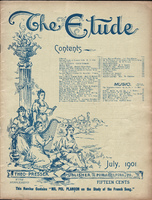This is the time of the year when every organist should look over his repertoire and make plans for next season. As the present season draws to a close and the various duties of an organist are diminished to the lowest point, he or she can profitably “take account of stock,” as it were. How many individual organ-compositions have been played for preludes, postludes, and offertories during the past season and how many times has each composition been repeated? What compositions have been worn “threadbare” by constant repetition season after season?
There are fifty-two Sundays, and if an organist has two services every Sunday, with an offertory every
Sunday morning, he would have to play 104 preludes, 104 postludes, and 52 offertories. Very few organists have so many services in a year, but I have purposely taken the maximum number for illustration.
If an organist plays each composition twice in the year, he will require 52 preludes, 52 postludes, and 26 offertories, 130 compositions in all. To an organist with a large repertoire this number would be small, but I am considering only those who have limited repertoires.
Now, 130 compositions is not a very large number for one to be familiar with, but the trouble is that many organists wish all these compositions to be just like some one ideal composition. If an organist considers Batiste’s “Pilgrim’s Song of Hope” as his ideal prelude, he wishes for 56 compositions of that style, and in despair he can discover only about a dozen. If his taste is of a higher level, and he holds Handel’s “Largo” as his ideal prelude, he seeks 56 “Largos,” but he, too, can discover but a dozen.
It seems to me that herein lies the secret of the limited repertoire of which so many organists complain. I have received numerous requests for a list of a dozen compositions “just like the ‘Cantiléne Nuptiale’ of Dubois” or “just like the ‘Hymn of Nuns’ of Wely,” etc., etc. These two compositions, while of entirely different calibre, are extremely popular, for two reasons. First, because the melody in each is tuneful, simple, easily grasped and held in the mind, and, secondly (I am inclined to think that this is the principal reason), because almost any organist can “try it over twice” and give a fairly acceptable performance on Sunday morning.
To illustrate further my point. One of my pupils took the “Cantiléne” for a lesson, played it in church, and was pleased with the result. A short time afterward he asked if I could give him another composition of exactly that style.
I knew his weakness (a tendency toward laziness) and said: “Let me see! The ‘Cantiléne’ is a solo for Oboe and Flute, 4 feet, with Tremulant.”
“Yes, yes, that is it,” he replied eagerly.
I went on: “The accompaniment is Dulciana, and the composition ends with a prolonged trill.”
“Yes, that is just the idea,” he responded.
I sat down at the organ and played another composition for him. The melody I played as a solo with Oboe and Flute, 4 feet, with Tremulant. The accompaniment I played on the Dulciana, and, as the composition ends with a trill, I prolonged it for his benefit.
When I had finished he exclaimed: “That is just the piece. Give me the name of it and I will play it next Sunday.”
I asked him if he were thoroughly satisfied, and would conscientiously learn the composition for next lesson, to which he replied:
“Why, certainly.”
I then wrote down the name of the composition for him. “‘Aria from Suite in D,’ of Bach, arranged by Whitney.” His face dropped at the name of the composer, but I reassured him that he had just heard the composition and had enjoyed it. At the next lesson I noticed that his step was less buoyant, and I asked him if he played the “Aria” in church Sunday.
He replied: “No, I could not make the thing go.
I tried it over a couple times before service, but I could not get interested in the piece.” The fellow was, at heart, quite conscientious, and, after I had urged him, he worked on the composition till he played it well, and ever since that time he has enjoyed the “Aria” as much as the “Cantiléne.”
Now, after this rather long digression, to return to the question of repertoire, I think it is possible for almost every organist who has a fair amount of capability to select 130 compositions for a repertoire for the year, which will be interesting to himself and his hearers, provided, of course, he does not demand “sugar” with every composition. At the end of the year about a third of these compositions could be laid aside and a number of new works added to keep the repertoire growing.
This is the time of year to plan such a change of repertoire, and I doubt if any organist who carries out such a plan will be disappointed.—Everett E. Truette.



